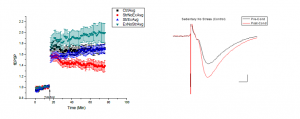Teresa Nufer (St. Pierre) and Jeffrey G. Edwards, Physiology and Developmental Biology
Both stress and exercise have significant physiological effects. Researchers have studied these effects throughout the body, and current evidence suggests that exercise and stress also have profound effects on the brain. While stress decreases brain function, exercise has been show to enhance brain function. Recently, researchers have begun to investigate the effects of stress and exercise on the brain simultaneously, instead of studying the effects individually. Our lab has furthered these studies through the use of electrophysiology and behavioral experiments. Four groups of mice were studied: a control group, a group that experienced a chronic stress protocol, a group that experienced regular exercise for at least a month, and a group that experienced both stress and exercise.
Electrophysiology involves studying the electric currents in live brain tissue. Mice (age 40-60 days) were humanely anesthetized and decapitated in accordance in preapproved IACUC protocol. Their brains were then sliced in oxygenated artificial cerebral spinal fluid (ACSF) using a machine called a Vibratome. The brain slices were then maintained in oxygenated ACSF at room temperature until they were used for experiments. A brain slice was placed in a chamber with constantly circulating ACSF at body temperature (approx. 28-31 degrees Celsius). Both a stimulating and a recording electrode were inserted (approx. 400-600 micrometers apart) into the stratum radiatum layer of the CA1 neuron population of the hippocampus. These are the neurons classically implicated in learning and the formation of short term memory. Cells were stimulated and their normal responses were recorded for approximately 15 minutes so as to establish a baseline. The neurons were then shocked at a high frequency for a few seconds to induce a “memory formation event,” also known as Long Term Potentiation (LTP). The greater the observed LTP, the greater the memory-formation ability. Following the shock protocol, neurons were then recorded from for another hour. Statistical analysis was performed on the data for the control group and the three experimental groups.
We also used a modified radial arm maze to behaviorally test the mice for increased (or decreased) learning and memory ability. Cheese was placed in a few of the arms and the mice were conditioned to learn the location of the cheese. Once the mice had all learned the maze, the location of the cheese was switched and the mice were timed as to how fast they were able to relearn the maze and find the cheese. The “smarter” the mouse, the more quickly it would be able to relearn the maze during the reversal phase. Though we had originally planned to use a Morris Water Maze, the radial arm maze turned out to be a better option for logistical reasons.
The results of the electrophysiology clearly show that exercise does indeed “rescue” the decrease in LTP that is normally observed in response to chronic stress (see Figure 1). AS we expected, the group that only experienced chronic stress had significantly lower LTP than the stress/exercise group (p<0.05), and the group that only experienced exercise had significantly higher LTP than the stress/exercise group (p<0.04). However, the LTP levels of the control group and the stress/exercise group are not significantly different (p=0.467). The behavioral experiments are currently in progress, so the results have not yet been analyzed. Researchers in the Edwards Lab will continue to work on and complete this phase of the project.
Figure 1: Black squares represent the control group, red diamonds represent the stress only group, green upside-down triangles represent the exercise only group, and the blue triangles represent the stress and exercise group. The results displayed here are averaged, normalized slopes of field Excitatory Post-Synaptic Potentials (fEPSP) like those shown to the right of the graph.

These results demonstrate the power of exercise to counteract the negative effects of stress on the brain. Interestingly, the ability of stress and exercise to modulate memory-forming capacity in similar, but opposite, ways suggests that both use and modify the same system. While regular exercise is generally considered healthy for the cardiovascular system, these results indicate that exercise may also be necessary to keep our brains “in shape” by counteracting the negative physiologic effects of stress, which everyone experiences to some degree. More research needs to be done to show the effect of exercise and stress on other brain regions besides the hippocampus.
Chronic stress commonly leads to anxiety and other undesirable conditions in humans. This data conclusively shows that exercise could alleviate stress and anxiety in the brain. Preliminary data was presented by me and my colleague, Jacob Trotter, in an oral presentation at the Utah Conference for Undergraduate Research in February 2014.
